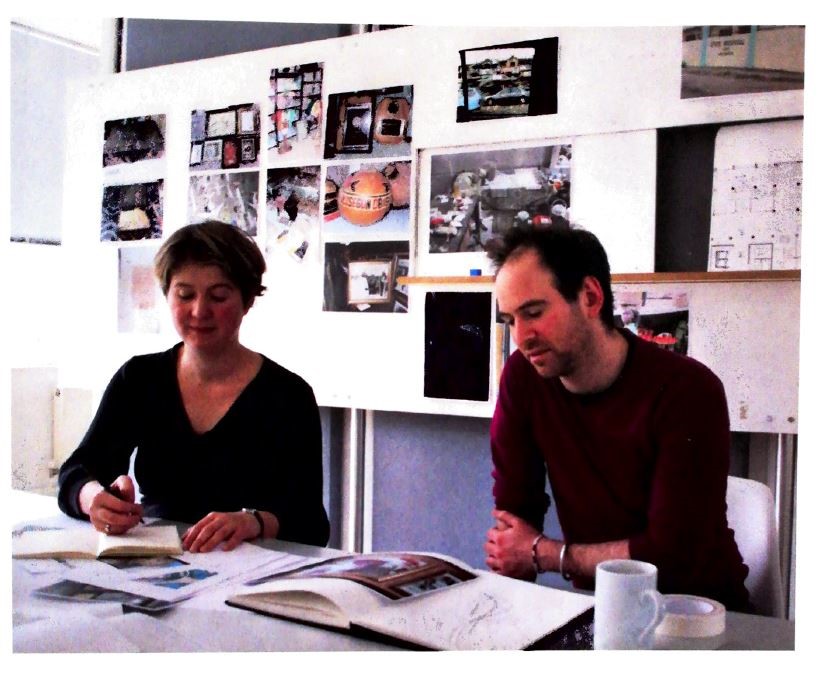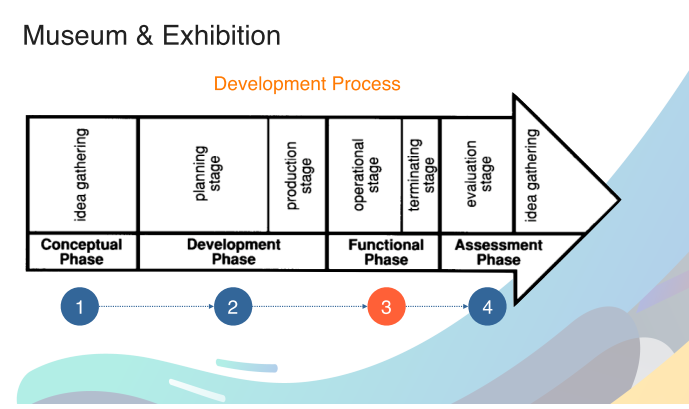Before explaining in detail the strategies used by Science Centers to promote learning and conveying message, it is necessary to have more insights about what are the basics of exhibition design, and what is the process used by exhibition designers.
I’ll present this methodology showing first the early research phase of the exhibition, the consideration of the space, light and graphics to emphasize the content, and the basics of interactivity and some tools used in exhibition design. Then, I will present the basics of science exhibition history and properties and I’ll show and analyze a few best pratices examples.
The 3 phases of the exhibition design process :
In his book, Exhibition design, David Dernie explains that the exhibit design processes goes through 3 phases :
- Research phase : the exhibition idea or concept is created, tested and refined. The principal outcome of this phase is a deep institutional understanding of what the exhibition is about and why the museum is doing it at this time ; in this way, and at this scale. This understanding is recorded in the exhibition brief.
- Design phase : is when the interpretive plan and all the research conducted to date is transformed into 3D through the creativity and insight of the designers working collaboratively with representatives of museum departments, interpretive planners, and evaluators.
- Implementation phase : is the building and installation of the exhibition. Project and financial management are crucial to ensure on time and on budget culmination of the exhibition process.
Exhibition design is a reccurent and iterative process, adapting and adjusting to exhibitions of varying sizes and budets, level of complexity, purpose.
But why are exhibitions created in the first place ?
Exhibition are the principal means by which museums can be of service to us. They can confirm, question or shake our beliefs or they may arouse a new interest or deepen our understanding of ourselves and the world we live in. The purpose of museum exhibitions should be both educational and entertaining.
The first questions that the designers have to consider are ; why is the exhibition necessary, what is the best way to communicate content, who are the visitors and what kind of experience do they want to offer ?
Where does Museum Exhibition Ideas come from ?
Successful museum exhibition program should be both research based and market driven : the idea of an exhibition can come internally from the analysis and interest of the museum staff or can be oriented from the public interest and demand. The target audience depends on the type of exhibition, and sometimes designers need the insights of other professionnals such as educators when designer exhibits for children, for example.
Each museum staff member who wishes to do research should prepare an annual personal research plan. It should propose a methodology that addresses both the academic and the pratical implications, financial and project a schedule for completion of the research. Each individual’s research plan should be subject to review and approved.
Who is the exhibition for and why ?
Surveying visitors is crucial to learn who they are and why they attend, as well as which museum offering attracted their visit on that particular day. With this information, museums can better communicate with their current audiences and expand them, learn how to be relevant to their needs and to the needs of the communities in which they live, and determine how better to serve them [1].
The research phase : writing the brief
The development of an exhibit begins with a planning stage and meetings with the client to discuss their expectations of the exhibit. Every detail should be described in what is called a brief. It is the formulation of the understanding of the project by the designer, and it specify the tasks and details the informations to take in account. The client and the designer have different roles that can be resumed as follows :

When writing a brief, the designer has to consider those inputs :
– visual identity and brand information: it is important for the designer to understand the client’s identity so that he can then design content in accordance with this vision.
– target audience research: another important step is to obtain information about the main target(s) of the exhibition. The target audience depends on the type of exhibition, so for a science center, children are more likely to be targeted, whereas an art gallery would be more targeted at adults. The designer often uses external research teams to learn about the learning styles of his visitors, what he likes and dislikes, and what he does not like.
– reception of visitors: another preliminary step is to take into account the arrival areas and the organization of the arrival and visits according to the number of visitors. It is all the more crucial nowadays in times of covid to limit visitor entries.
– storyline: the storyline is a document describing the elements of the exhibition and quickly retracing the exhibition in zones, or different stages. It is a way of tracing the exhibition’s route. At this stage it is superficial.
– the tone of the exhibition: the tone of the exhibition is as important as the exhibition itself. It differs according to the type of content, and must be taken seriously especially for historical museums recounting wars or other dramatic events.
– the content document: this is a detailed descriptive list listing the different contents, their types and description that should be present in the exhibition. It can be more or less provided depending on the museum, and serves as a basis for the designer to design the museum experience.
– back home messages: the designer must discuss and agree with the client on the purpose of the exhibition and the key messages to be conveyed to visitors. The designer is not only responsible for the style of the exhibition but also for its comprehension and the overall visitor experience. It is also necessary to ensure continuity between the information displayed on the various media: the website, the leaflets and the content present in the exhibition. All this must allow the visitor to have a global view of the message to be retained.
– creative workshops: In general, designers designing an exhibition create creative workshops where they share their ideas and inspiration on their vision of the exhibition. This is the starting point of the creative phase but it also help the designer and the client to make sure they have the same language and tone when thinking about the exhibition [2].

Sources :
[1] Exhibition design, David Dernie
[2] Exhibition Design, Philip Hughes
